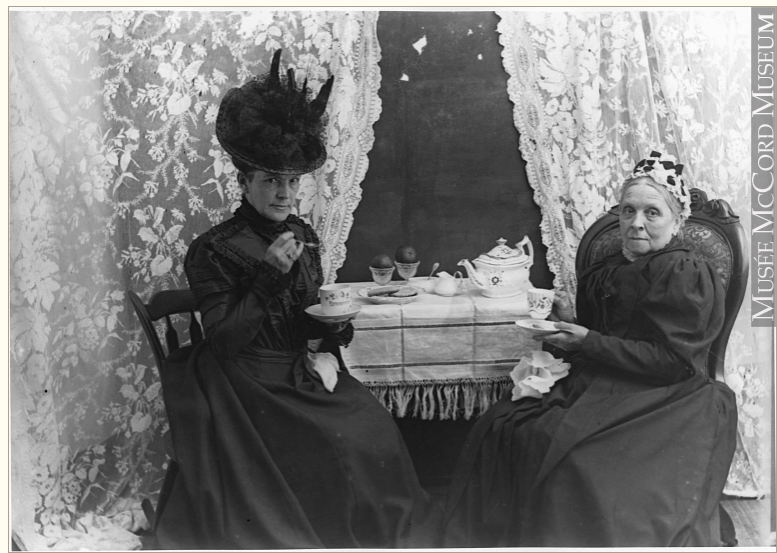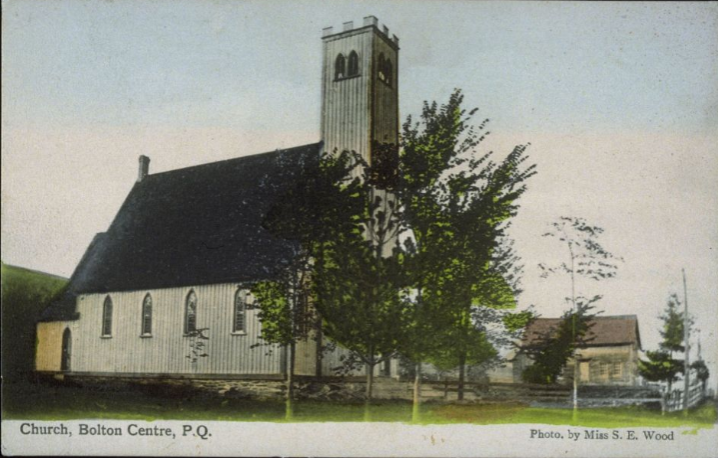Sally Elizabeth Wood: Defying Traditional Womanhood of the White Bourgeois Canadian Society Through Photography
NOVEMBER 27, 2020

Roxanne Cornellier
Canadian photographer Sally Elizabeth Wood (fig. 1), also known as Sally Eliza Wood, was born in Knowlton, Quebec in 1857. As a bourgeois white woman, Wood used her privilege to defy 20th-century gender norms; she received professional training at William Notman’s photography studio in Montreal sometime before 1897, which helped pave the way for her career in Quebec. Notman (1826-1891), a Scottish-born Canadian photographer with 20 studios across Canada and the United States1, was the most famous photographer of Montreal2 at the time, as well as the official Photographer to the Queen3. He was proficient in portraits as well as landscapes, genre, and composites4. His influence on Wood is apparent, in that she, too, produced work in many photography genres5. Wood took several portraits (fig. 2), but her collections also include images of domestic scenes (fig. 3), architectures, landscapes, as well as some coloured postcards6. She worked with a variety of materials such as glass plate negatives, dry gelatin plates, silver gelatin prints, carte-de-visites, and silver gelatin7. In 1890, she worked as a substitute for artist John A. Wheeler in his studios in Knowlton and Cowansville8, which allowed her to train more extensively, to receive a salary, and to acquire future clients. When Wheeler retired in 1897, Wood opened her own studio in Knowlton, thus taking over the photography business of her hometown9.
Female photographers were quite rare at the end of the 19th century, as the field was dominated by men. Wood’s opportunities for professional training and support were available to her because of her status as a bourgeois white woman10; she could afford to study privately under the most famous photographer in Montreal, although she only opened her own studio at the age of 4011. Photography was deemed unsuitable for women because of the heaviness of the materials it required12. Unless the artist had a studio, their materials had to be carried around –– Wood carried her own around, as she searched for the most picturesque sites to be photographed for her 1905-1910 postcard series. Some examples of that series include Church, Bolton Centre (fig. 4) and Falls at the Outlet, Brome Lake (fig. 5), which were coloured and published by the Scottish company, Valentine & Sons13.
Wood’s postcard series is signed entirely as “Miss S.E. Wood.14” The title “Miss” simultaneously highlights the photographer’s gender and marital status. Its inclusion reflects her pride in defying traditional gender roles; Wood would not settle down with a husband nor a family. Since the postcards were signed around 1905, when she was nearly 50 years old, it is probable that she remained unmarried until her death. This allowed her to have a long, uninterrupted career because she was never forced into caring for a husband and children, as most women did at the time. She also had the financial means to pursue an artistic career with professional training.
Sally Elizabeth Wood’s extensive collection of photographs and postcards are archived at the Brome County Historical Society, while others are kept at the McCord Museum in Montreal15. Her works at the McCord Museum are, however, filed under Notman’s archives16, despite the fact that they were produced much later after her apprenticeship, once she had acquired her own Knowlton studio. Through her work, Wood proved that photography was suitable for women, and she rejected the traditional roles of women in the late 19th century. The fact that part of her work is still filed under Notman’s archives is a reminder of the low status of female artists at the turn of the 20th century. Wood’s work is ultimately still denied the extensive recognition it deserves.





- Marian Scott, “William Notman: Portrait of a Visionary Photographer at McCord Museum,” Montreal Gazette, November 6, 2016, https://montrealgazette.com/entertainment/arts/first-notman-exhibition-in-22-years-opens-window-into-victorian-montreal.
- Scott, “William Notman: Portrait of a Visionary Photographer.”
- Albert Kish, Notman’s World, (Toronto: National Film Board, 1989).
- Albert Kish, Notman’s World.
- “Parcours: Sally Eliza Wood,” Centre Vox, accessed November 18, 2019, http://www.centrevox.ca/fd/parcoursfemmesphotographe/francais/woodf.htm.
- Matthew Farfan, “Sally Elizabeth Wood (1857-1928),” Townships Heritage WebMagazine, accessed November 16, 2019, http://townshipsheritage.com/article/sally-elizabeth-wood-1857-1928.
- Matthew Farfan, “Sally Elizabeth Wood (1857-1928).”
- Matthew Farfan, “Sally Elizabeth Wood (1857-1928).”
- “Parcours: Sally Eliza Wood.”
- “Parcours: Sally Eliza Wood.”
- “WOOD, Sally Elizabeth (Sally Eliza),” The Canadian Women Artists History Initiative, last modified July 17, 2012, https://cwahi.concordia.ca/fr/sources/artists/displayArtist.php?ID_artist=5627.
- Matthew Farfan, “Sally Elizabeth Wood.”
- “WOOD, Sally Elizabeth (Sally Eliza).”
- See figures 5 and 6 for her signature.
- “Parcours: Sally Eliza Wood.”
- “Parcours: Sally Eliza Wood.”
Bibliography
Bureau, Lucie. “Le portrait photographique au Québec: Les cas de Sally Eliza Wood (1857-1928) et de Marie-Alice Dumont (1892-1985).” Université de Montréal Press, 2007.
Distad, Merrill. “The Postcard-A Brief History.” University of Alberta. Accessed November 16, 2019. http://peel.library.ualberta.ca/postcardhistory.html.
Farfan, Matthew. “Sally Elizabeth Wood (1857-1928).” Townships Heritage WebMagazine. Accessed November 16, 2019. http://townshipsheritage.com/article/sally-elizabeth-wood-1857-1928.
Georges, Karoline. “Dispositifs du regard.” Vie des arts 50, no. 201 (2005): 71-72.
Kish, Albert. Notman’s World, Toronto: National Film Board, 1989.
MacInnes, Teresa. The Other Side of the Picture, Toronto: National Film Board, 1998.
Marcil, Madeleine. “Images de femmes: Les Québécoises photographes.” Cap-aux-Diamants: La revue d’histoire du Québec 21, (1990): 39-41.
Marcil, Madeleine. “Femmes et photographie au Québec, 1839-1940.” Université du Québec à Montréal Press, 1990.
Mousseau, Sylvie. “Des clichés qui mettent en lumière un héritage photographique.” L’Acadie Nouvelle, no. 33, Oct. 27, 2006.
O’Reilly, Patricia. “Introduction.” In Rethinking Professionalism: Women and Art in Canada, 1850-1970. McGill-Queen University Press, 2012.
Scheffer, Carole. “Architectural Postcards and the Conception of Place: Mediating Cultural Experience.” PhD Thesis, Concordia University, 1999.
Scott, Marian. “William Notman: Portrait of Visionary Photographer at McCord Museum.” Montreal Gazette. Accessed November 17, 2019. https://montrealgazette.com/entertainment/arts/first-notman-exhibition-in-22-years-opens-window-into-victorian-montreal.
Vendette, Marie-Hélène. “The Origin and the Evolution of the Postcard,” McCord Museum. Accessed November 17, 2019. http://collections.musee-mccord.qc.ca/scripts/explore.php?Lang=1&tableid=11&tablename=theme&elementid=97__true&contentlong.
“Parcours: Sally Eliza Wood,” Centre Vox. Accessed November 18, 2019. http://www.centrevox.ca/fd/parcoursfemmesphotographe/francais/woodf.htm.
“The History of Photography in Pictures,” Science & Media Museum. March 8, 2017. https://www.scienceandmediamuseum.org.uk/objects-and-stories/history-photography.
“Valentine’s Co. Ltd. (Valentines & Sons), 1825-1963,” MetroPostcard. Accessed November 18, 2019. http://www.metropostcard.com/publishersv.html.
“What’s in a Title?,” McCord Museum. March 2017. https://www.musee-mccord.qc.ca/en/collections/photography/whats-in-a-title/.
“WOOD, Sally Elizabeth (Sally Eliza),” The Canadian Women Artists History Initiative. Accessed November 15, 2019. https://cwahi.concordia.ca/fr/sources/artists/displayArtist.php?ID_artist=5627.